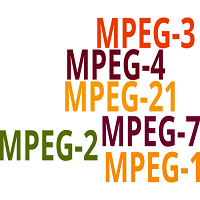What is MPEG?
A number of MPEG standards are in current use, and more are sure to follow. Some well-known standards are explained briefly below.
MPEG-1: This first set of standards was developed for audio and video compression. Layer 3 is a codec within these standards, known simply as MP3, or the popular audio compression format for music.
This video format was used to store movies on CDs, known as Video CD, or VCD. Quality is equal to that of a VHS tape, and compatibility playback on CD/DVD players is high. One drawback of this standard is that it only supports progressive footage, verses the inclusion of interlaced. These terms relate to the way a picture paints itself across a screen. Progressive monitors (including progressive TVs) paint a picture "from top to bottom" progressively in a single, sequential pass. Interlaced displays paint every other line, then fill in the odd lines in a two-pass process.
MPEG-2: This standard improved on MPEG-1
by including the ability to encode interlaced pictures. It is widely
used for digital cable, satellite and over the air digital signals. This
format is also prevalent for movies distributed on DVD. Television
receivers, DVD players and television stations typically incorporate
this standard.
MPEG-2 also contains two container formats: the Transport Stream and Program Stream. These relate to the way digital broadcasts are transmitted and formatted to media, respectively.
MPEG-3: The intention was to make this standard compatible with high-definition TV (HDTV), but this became unnecessary when MPEG-2 extensions expanded that standard's ability to encompass HDTV. At that time, this standard was abandoned.
MPEG-4: Borrowing from the first two standards, MPEG-4 extends functionality of audio/video compression by improving format flexibility. It supports 3-D rendered objects, as well as incorporating the copyright protection scheme known as Digital Rights Management (DRM). This standard can be used for broadcast television, online streaming media, applications such as videophone, and distribution on digital media.
The MPEG-4 standard is developed in “parts” associated with some well-known codecs. For example, DivX, Xvid, Nero Digital and Quicktime6™ are a few codecs that use part 2. A different version of Nero Digital (AVC), and Quicktime (version 7) use part 10, as does the x264 codec. Blu-ray discs and some types of HD DVDs also use this flavor.
MPEG continues to develop (non-sequentially numbered) standards, such as MPEG-7 and MPEG-21, dedicated to multimedia content.
MPEG-2 also contains two container formats: the Transport Stream and Program Stream. These relate to the way digital broadcasts are transmitted and formatted to media, respectively.
MPEG-3: The intention was to make this standard compatible with high-definition TV (HDTV), but this became unnecessary when MPEG-2 extensions expanded that standard's ability to encompass HDTV. At that time, this standard was abandoned.
MPEG-4: Borrowing from the first two standards, MPEG-4 extends functionality of audio/video compression by improving format flexibility. It supports 3-D rendered objects, as well as incorporating the copyright protection scheme known as Digital Rights Management (DRM). This standard can be used for broadcast television, online streaming media, applications such as videophone, and distribution on digital media.
The MPEG-4 standard is developed in “parts” associated with some well-known codecs. For example, DivX, Xvid, Nero Digital and Quicktime6™ are a few codecs that use part 2. A different version of Nero Digital (AVC), and Quicktime (version 7) use part 10, as does the x264 codec. Blu-ray discs and some types of HD DVDs also use this flavor.
MPEG continues to develop (non-sequentially numbered) standards, such as MPEG-7 and MPEG-21, dedicated to multimedia content.




This is really in-depth and I didn't really know what it is but I do now! so thank you for sharing!
ReplyDeleteSophia xo // https://sophiaaaxo.com
Thanks a lot dear.
DeleteIts so complicated thank god you explain it all ..
ReplyDelete